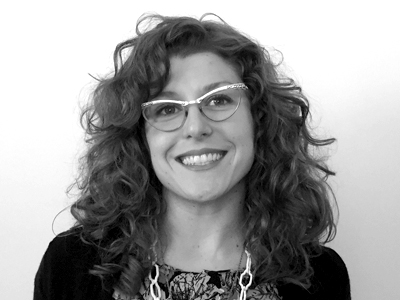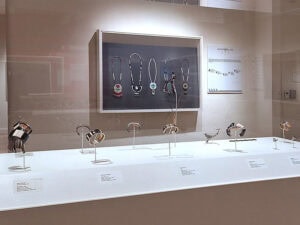
Chicago’s Lillstreet Art Center is home to artist studios, art classes in a variety of mediums, an artist-in-residence program, and the multiple exhibition spaces that make up Lillstreet Gallery. In this interview, I speak with Jewelry Curator Nora McCarthy about her role in presenting contemporary jewelry in both exhibitions and commercial venues at Lillstreet Gallery.
Adriane Dalton: Begin by telling our readers about Lillstreet Gallery and your role as jewelry curator.
Nora McCarthy: Lillstreet Gallery is the gallery and exhibition space within Lillstreet Art Center. Located in the gorgeous, art-loving Ravenswood neighborhood on Chicago’s north side, we occupy a three-story converted gear factory and offer classes in ceramics, metalsmithing, drawing and painting, printmaking, textiles, and digital media. Our 40,000-square-foot facility includes 25 classrooms and 48 artist studios, and we average 1,800 students per term.
Lillstreet Gallery consists of three exhibition spaces: the Main Gallery, the Annex Gallery, and the Rooftop Gallery. The Main Gallery represents emerging and established artists working in ceramics, metalsmithing, painting, and more, with an adjacent shop dedicated to sellable work in these mediums. The Annex Gallery represents emerging and established Lillstreet artists and community members working in a variety of mediums. The Rooftop Gallery is a unique, one-of-a-kind exhibition space, hosting artists from around the country and inviting them to install work onto four 9-foot flagpoles on top of Lillstreet’s rooftop deck.
As lead jewelry curator, I work to identify the artists we represent in our shop—both in the art center and online. I oversee product merchandising, manage inventory, collaborate with gallery staff on social media platforms, and act as a liaison between the customer and the artists. I love it, it truly is a dream job!
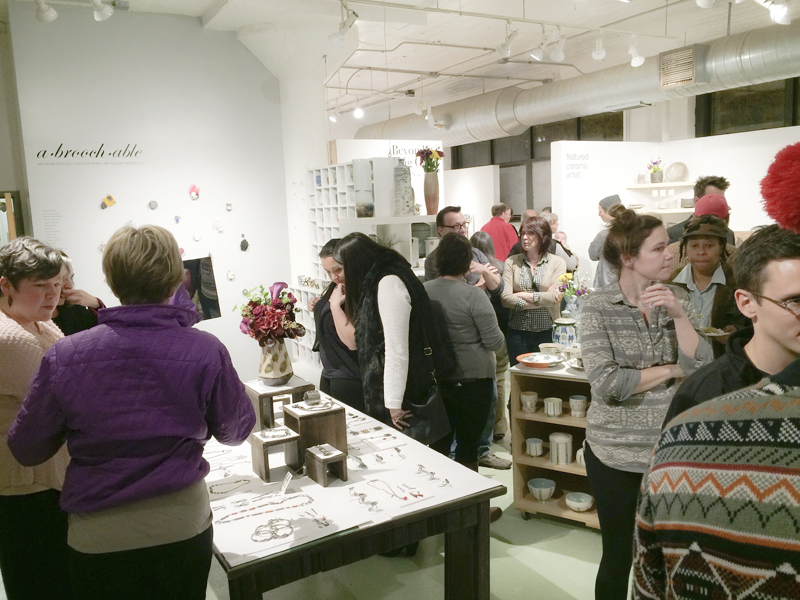
What is your educational background, and what are the origins of your interest in jewelry?
Nora McCarthy: I received my BFA with a concentration in metalsmithing from the University of Illinois at Urbana-Champaign, though the origins of my interest in jewelry extend into my early childhood. I was always collecting beads and stones for beading and wire-wrapping, and a family friend taught me how to string pearls when I was only 10 years old. My dad loves to tell people that he knew my career in basketball wasn’t going very far when I brought my beading kit with me to basketball camp in junior high.
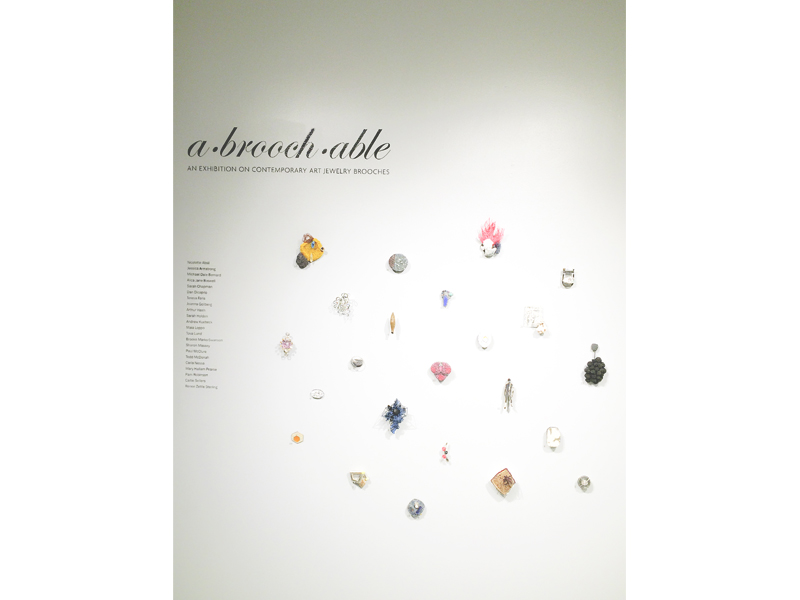
Describe your curatorial process. How do you select works for the gallery? What qualities are important in selecting work for your venue and your audience?
Nora McCarthy: With every artist we represent, we strive to inspire a vibrant visual arts community and create opportunities that encourage artistic growth in the individual. That has been our mission since 1975. Really there are two primary curatorial processes—one for exhibitions, and the other for retail sales in the shop. Curating for the exhibitions closely relates to the “inspiring” aspect of our mission. For exhibition artists and collections, we focus heavily on a specific theme, concept, or creative process. Conversely, when selecting work for the shop, we need to closely consider how sellable items are—wearability and functionality are two important qualities of those selections. Each curatorial process differs, but both relate closely to the overall mission of Lillstreet.
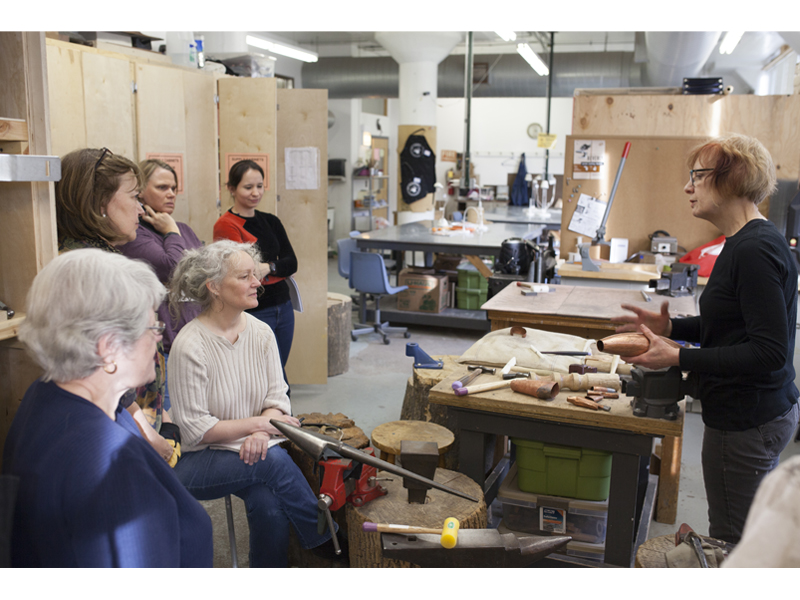
How does your curatorial process for an exhibition differ from selecting works for the shop?
Nora McCarthy: The Main and Annex Galleries are open to exhibitions in a plethora of mediums, so the process for selecting works is adapted to each show depending on the theme. This is often decided upon by the gallery director, Brian Malnassy, and a guest juror or curator.
In curating for the shop, I try to maintain a collection that showcases a variety of techniques and materials. Because we’re an art center, much of our customer base consists of students of all ages and backgrounds, so the audience is broad. In taking jewelry classes at Lillstreet, our students gain an appreciation for the skills, time, and tradition that handmade jewelry requires. By displaying bodies of work in a variety of techniques, we show the students successful executions of many different metal processes. This serves as both inspiration and incentive to purchase and wear art jewelry.
![[left] Laura Wood, Open Weave Scoop Hoops with Fringe, 2017, brass, sterling silver, powder coat, cobalto calcite, moonstone, phantom quartz, steel, 1 x .75 x 4.5 inches, photo: Guy Nicol [right] Laura Wood, Open Weave Ring, 2017, brass, sterling silver, powder coat, labradorite, 1.5 x 1.5 x 1.25 inches, photo: Guy Nicol Laura Wood, Open Weave Scoop Hoops with Fringe, Open Weave Ring, 2017](/sites/default/files/img_GINT_ADALTON_Nora%20McCarthy_07_Laura%20Wood%20Earrings_08_Laura%20Wood_Ring_600x800px.jpg)
How important is the commercial viability of the work to your curatorial process? How important is presenting challenging or high-concept art jewelry in a commercial gallery setting?
Nora McCarthy: I try to maintain a range of accessibility in the jewelry we stock so as to appeal to more people. The work scales from edgy yet “everyday” pieces like work by artist Erica Bello to larger statement pieces like those of Laura Wood. The materials in the shop vary from emiko oye’s colorful and bold LEGO jewelry to silver and gem-centric works by Joanna Gollberg. So the commercial viability of the jewelry is important when selecting work for the shop, but much of the reason Lillstreet has a gallery and shop is to serve as a resource and a platform for our students, the greater craft community, and art jewelry appreciators.
The shop portion of the gallery is certainly more of a commercial gallery setting, but I definitely believe it’s a priority of Lillstreet’s to present high-concept art jewelry during jewelry-related exhibitions, such as Behold: Modern Metal Vessels (2015) and Sense of Scale (2014).
Lillstreet Gallery hosts roughly one jewelry-centric exhibit annually. How are these exhibits developed? Are there plans to expand the number of jewelry exhibits in the future?
Nora McCarthy: There are definitely plans to expand the number of jewelry exhibits in the future. In addition to having at least one jewelry-centric exhibit in the Main Gallery every year, we host a more intimate jewelry show in conjunction with SOFA Chicago, which attracts a considerable number of metalsmiths and collectors to our city. In 2018, Lillstreet will host a larger metals exhibit in the Main Gallery space concurrent with SOFA Chicago. We are also in the process of planning a collaborative ceramics and metals show.
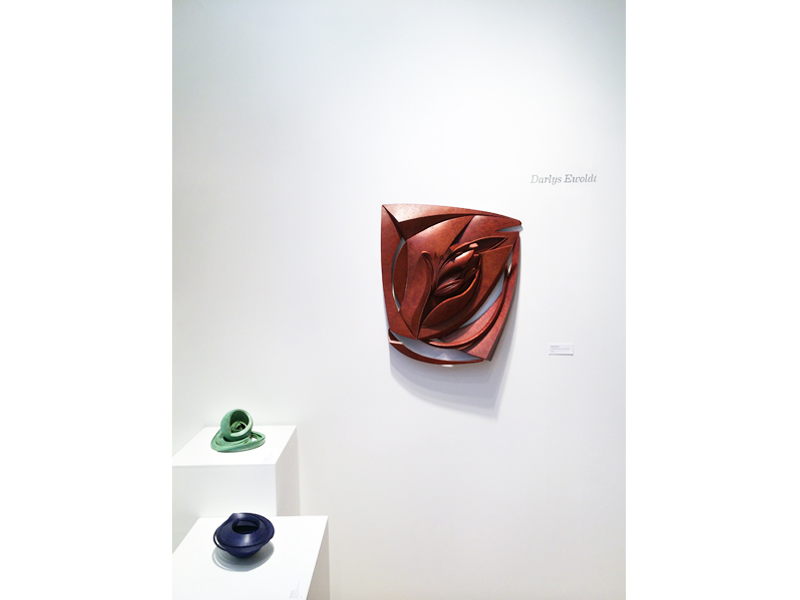
As jewelry curator, are you involved in the selection process for the artist-in-residence program? Do you work with the jewelry artists during their residency?
Nora McCarthy: Our artists in residence (AiR) are all selected by the directors of our education departments. Pam Robinson, director of metalsmithing, jewelry, and glass, reviews submissions for metals resident artists. This year we’re fortunate to have two very talented residents: Aurélie Guillaume and Peter Antor. We sell works by both Aurélie and Peter in the Gallery at Lillstreet. So I do work closely with our residents from a retail perspective.
Every spring, as a part of the jewelry residency, the AiRs are required to curate or jury and display a metals exhibition on a contemporary jewelry topic of their choice. Our resident artists also teach classes in the art center as part of their residency. I’m currently enrolled in one of Peter Antor’s classes to better understand the process behind much of his work in the gallery. This both enables me to speak about the work with potential patrons and satiates my personal curiosity. I plan to take a cloisonné enameling class with Aurélie as well. Unfortunately, I often get “booted” because their classes fill up so quickly—which is great!

What’s on the horizon, jewelry-wise, in 2017 at Lillstreet Gallery?
Nora McCarthy: We’ve recently added jewelry to our gallery website, and in conjunction with that, we’ve launched a Featured Jewelry Artist program. We have some amazing artists lined up and will be showcasing larger bodies of their work, limited editions, and one-of-a-kind pieces.
There’s an exciting metal sculpture show coming up in mid-April curated by our teaching artist, Darlys Ewoldt. In July, we’ll have our annual artist-in-residence show, a culmination of the year’s works by all seven residents. For the first time ever, we will have two metals resident artists—both of whom are extremely talented—so that will be very exciting for us! And of course, in conjunction with SOFA, we’ll have a jewelry-related show. The past two years we have featured brooches and sculptural rings, and I’m excited to announce this year’s theme soon. Look for that call-for-entry!
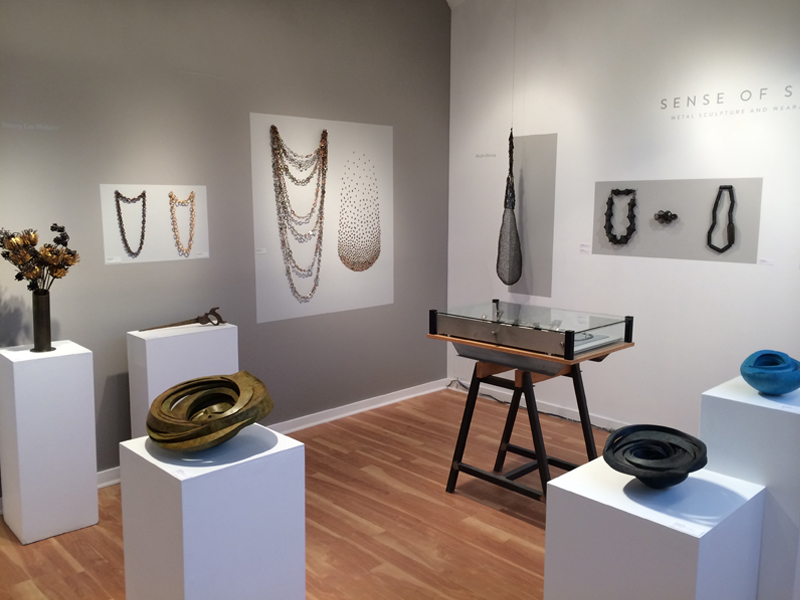
Have you consumed any compelling media lately? Books, articles, films, music?
Nora McCarthy: I’m currently working my way through The Design Book, published by Phaidon. It’s a compilation of objects that haven’t changed since their original design and are still in production today—the safety pin, for example, which was designed by New Yorker Walter Hunt in 1849. There are some seriously inspiring forms in there, many of them everyday objects with very interesting origins.
Additionally, both of our resident artists have been getting some noteworthy media attention. Toni Greenbaum wrote Tooning into Enamel: Zachery Lechtenberg and Aurélie Guillaume for Metalsmith magazine, vol.36, n°5. Current Obsession published a great feature on Aurélie’s solo show, Mauricette, The Giants, and Other Frivolous Tales: The Jewellery of Mlle. Guillaume at Reinstein/Ross in New York. Patrick R. Benesh-Liu wrote an inspiring interview of Peter Antor as an emerging artist for Ornament magazine in volume 39.2.

What advice would you offer to anyone pursuing a career in jewelry curation?
Nora McCarthy: Working in a gallery is always a great place to start learning the fundamentals–like merchandising and selling. Subscribe to relevant magazines and stay tuned to AJF and SNAG. Visit as many galleries as you possibly can!
What advice do you have for artists who are seeking representation with galleries?
Nora McCarthy: Self-promote via social media and by wearing your own jewelry. Wearing your jewelry is the best advertisement; you never know with whom you might strike up a conversation.
Sell at craft shows. A lot of curators and gallery directors go to these to find new artists to carry, and many of the emerging artist options are very reasonably priced and give you great visibility.
Treat your jewelry like a business. Keep your website current and clean, consider professional product photography, and respond to e-mails or calls in a timely manner.
Although it can be hard to get through sometimes, e-mailing galleries tends to be more effective than cold-calling. When seeking representation, I would advise artists not to approach galleries during normal business hours unless you have previously arranged a meeting for that purpose. A gallery’s hours of operation are dedicated to representing and selling works by artists to whom they have already committed.
